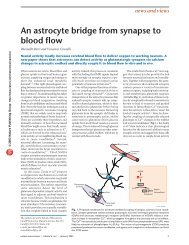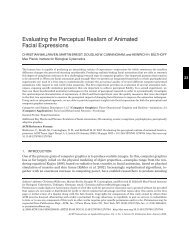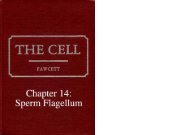Chapter 12: Centrioles
Chapter 12: Centrioles
Chapter 12: Centrioles
Create successful ePaper yourself
Turn your PDF publications into a flip-book with our unique Google optimized e-Paper software.
CENTRIOLES<br />
The dense material that forms the capitulum and the cross-striated columns of the<br />
connecting piece in spermatozoa is formed in intimate association with the proximal and<br />
distal centrioles, respectively. These versatile organelles are believed to play a<br />
dominant role in the organization of these components of the spermatozoon. The<br />
cross-striated columns of the connecting piece are probably homologous to the<br />
cross-striated rootlets that often extend downward from the basal bodies into the<br />
cytoplasm of ciliated epithelial cells.<br />
Traditionally the basal bodies were regarded as kinetic centers responsible for<br />
initiating the beat of cilia and flagella. This interpretation is no longer tenable. It has<br />
been shown that sperm tail movements continue after laser microbeam destruction of<br />
the centriolar region (Lindemann and Rikmenspoel, 1972). Moreover, electron microscopic<br />
studies of spermatogenesis have shown that the distal centriole which initiates<br />
development of the flagellum later disintegrates and is no longer present in the mature<br />
spermatozoon. The juxtanuclear centriole usually persists, occupying a niche just<br />
beneath the capitulum that attaches the tail to the sperm head. In some species,<br />
however, this centriole also disintegrates during sperm maturation (Woolley and<br />
Fawcett, 1973). Thus centrioles are essential for development of cilia and flagella but<br />
are not required to initiate and maintain their beat. Observe in the accompanying<br />
micrograph that no distal centriole can be identified at the base of the axoneme.<br />
Figure 315. Nearly mature spermatozoon from the testis of a Chinese hamster. (From D. W. Fawcett Figure 315<br />
and D. M. Phillips, Anat. Rec. 165: 153-184, 1969.)









